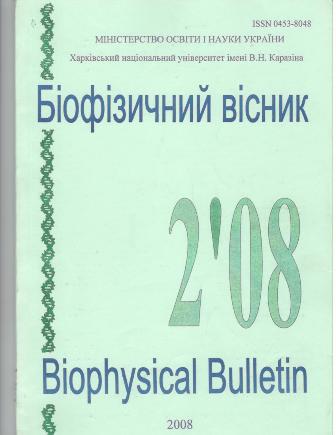Плівки Na-ДНК з іонами металів
Анотація
Структури плівок, отриманих випаровуванням з розчинів Na-ДНК тимусу теляти з концентрацією 0,2 мг / мл, що містять солі Li, K, Na, Cs, Mg, Zn, Ca, аналізуються при різних рівнях відносної вологості та температур. Розчин солі Na-ДНК об'ємом 0,5 мл виливали в скляну кварцову комірку, поміщену в герметичну закриту посудину з входами для перекачування повітря. Клітина має площу 420 мм 2 і висоту бічних стінок 1 мм. Похибка стабілізації температури в термостаті становила 0,5ºС, похибка вологості становить 2%. Дослідження проводили при температурах 30 і 40ºС. Отримані плівки Na-ДНК були сфотографовані в білому поляризованому світлі. Об'єм утвореної рідкокристалічної фази залежить від типу іонів у розчинах Na-ДНК і визначає кореляцію між площею структури на плівці та площею всієї плівки і залежить від кореляції концентрацій солі металу та ДНК . Площа, зайнята рідкокристалічними структурами, була розрахована як площа, обмежена кривою, що з’єднує граничні елементи структур.Відносні площі структур, отримані з розчинів, що містять сіль NaCl з концентраціями 20 та 1,25 ммоль, мають значення 0,73 та 0,09 відповідно. Плівки, що містять сіль MgCl2, мають сферулітові структури, що руйнуються в умовах кімнатної температури та вологості. Плівки, отримані з розчинів, що містять сіль LiCl, CsCl, CaCl2 або MgCl2 з концентрацією 10 мМ, не утворюють структур з виділеним напрямком росту скупчень. Плівки, отримані з розчинів, що містять сіль NaCl з концентрацією 10 мМ та солі ZnCl2, або CuCl2 з концентрацією 0,4 ммоль та 0,2 мм, відповідно не утворюють структур із виділеним напрямком росту скупчень. Припускається, що плівка може характеризуватися набором значень фрактальних розмірів; однією з ознак існування ДНК у природному вигляді є наявність таких фрактальних структур, як перколяційний анізотропний кластер в отриманій плівці.
Завантаження
Посилання
2. Tarasevich YY. Mechanisms and models of the dehydration self-organization in biological fluids (2004). Uspehi Fiz. Nauk , 7, 779-790.
3. Davidson MW, Strzelecka TE, Rill RL. (1988). Multiple liquid crystal phases of DNA at high concentration. Nature, 331, 457-460.
4. Bouligand Y, Livolant F. (1984). The organisation of cholesteric spherulites. J. Physique, 45, 1899-1923.
5. Evdokimov YM, Skuridin SG, Badaev NS. (1986). The proof of formation of two types of liquid crystal microphases of DNA molecules of low molecular weight in water-salt polyethylene glycol solutions. DAN SSSR , 286, 997-1000.
6. Golo VL, Evdokimov YM, Katz YI, Salyanov VI. (2000). Interaction of segments of nucleic acids owing to modification of a network of hydrogen bond of solvent. ZETF, 118, 959-972.
7. Blagoy YP, Galkin VL, Gladchenko GO, Kornilova SV, Sorokin VA, Shkorbatov AF. (1991). Complexes of metals of nucleic acids in solutions. Kiev: Naukova Dumka.
8. Andronicashvili EL, Esipova NG. (1982). Role of metals in the development of some tumours. Biophysica, 6, 1022-1026.
9. Sirover MA, Loeb LA. Infidelity of DNA (1976). Synthesis in vitro: screening for potential metal mutagens or carcinogens. Science, 7, 2331-2335.
10. Andronicashvili EL. (1987). Malignization and change of some physico-chemical properties of biomacromolecules and supramolecular structures. Biophysica, 5, 782-799.
11. Glibitskiy GМ, Krasnitskaja AA, Gudzenko VI. (2006). Structures of Na-DNA films received from solutions at various values of humidity and temperatures. Biophysical Bulletin, 1, 89-94.
12. Glibitskiy GM, Krasnitskaya AA. (2007). Way of definition of influence of substance on nucleic acid. Ukraine patent № 26115, bull. 14.
13. Frey E, Tauber UC, Schwabl F. (1994). Crosover from isotropic to direct percolation. Phys. Review E, 49, 5058–5072.
14. Smalyukh II, Zribi OV, Butler JC, Lavrentovich OD, Wong1 GCL. (2006). Structure and Dynamics of Liquid Crystalline Pattern Formation in Drying Droplets of DNA. Phys. Rev. Lett., 96, 1778.
Автори, які публікуються у цьому журналі, погоджуються з наступними умовами:
- Автори залишають за собою право на авторство своєї роботи та передають журналу право першої публікації цієї роботи на умовах ліцензії Creative Commons Attribution License, котра дозволяє іншим особам вільно розповсюджувати опубліковану роботу з обов'язковим посиланням на авторів оригінальної роботи та першу публікацію роботи у цьому журналі.
- Автори мають право укладати самостійні додаткові угоди щодо неексклюзивного розповсюдження роботи у тому вигляді, в якому вона була опублікована цим журналом (наприклад, розміщувати роботу в електронному сховищі установи або публікувати у складі монографії), за умови збереження посилання на першу публікацію роботи у цьому журналі.
- Політика журналу дозволяє і заохочує розміщення авторами в мережі Інтернет (наприклад, у сховищах установ або на особистих веб-сайтах) рукопису роботи, як до подання цього рукопису до редакції, так і під час його редакційного опрацювання, оскільки це сприяє виникненню продуктивної наукової дискусії та позитивно позначається на оперативності та динаміці цитування опублікованої роботи (див. The Effect of Open Access).





